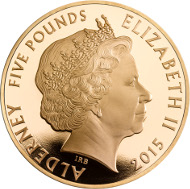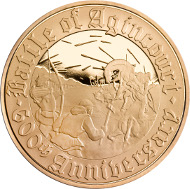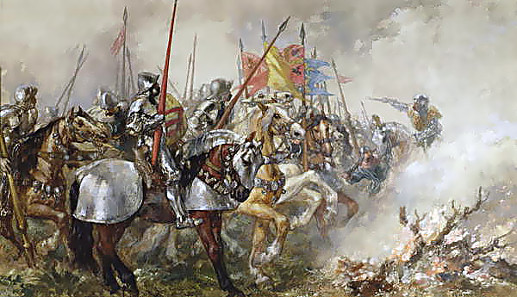November 12, 2015 – The Royal Mint is to strike coins commemorating the 600th anniversary of The Battle of Agincourt, regarded as one of history’s greatest military victories for England’s King Henry V. The limited edition £5 coins will be struck in Silver Proof and Gold Proof for Alderney.
The Royal Mint’s Director of Commemorative Coin, Anne Jessopp, said, “The Royal Mint has been producing coinage for the kings and queens of Britain for over 1,000 years, including coins from the reign of King Henry V, so it is apt that in 2015 we should mark this important anniversary.”
Alderney / 5 Pounds / Gold .916.7 / 39.94g / 38.61mm / Design: Ian Rank-Broadley FRBS (obverse) and Glyn Davies (reverse) / Mintage: 75.
The limited edition £5 coins will be struck for Alderney in 22 carat gold (mintage: 75 specimens) and in sterling silver to Proof finish (mintage: 1,500 specimens). The reverse designer is Royal Mint Engraver and Product Designer, Glyn Davies, whilst the obverse portrait is by Ian Rank-Broadley FRBS.
Modern day longbowman and Agincourt re-enactor, Graham Anderson, with The Royal Mint’s coin marking 600 years since the Battle of Agincourt.
Engraver Glyn Davies’ design for the Battle of Agincourt coin places the audience right at the heart of the scene: “The idea behind my approach to the design was to show the overwhelming odds against the diseased and weakened English army that defeated that of the French. Although the battle is famed for the use of the Longbow, much of the disaster that befell the French army was, however, due to their belief in a chivalrous code of conduct.
I tried to get a sense of the mayhem and confusion that the French forces fell into and the significant role the archers performed in the battle. The design shows a lightly armoured archer in the foreground with a hatchet or hammer, weapons thought to have caused damage and deaths to the French knights as did suffocation in the mud. The French are depicted in heavy armour and on horseback. Trees surround the field as they also played a significant role in the French defeat.”
Morning of the Battle of Agincourt. Painting by Sir John Gilbert, 1884.
Fought on 25 October 1415 the Battle of Agincourt, a pivotal moment in the Hundred Years’ War, is characterised by the muddy terrain, the deadly longbows used by the English and Welsh archers, and the strategic tactics employed by King Henry V. The story may date back six centuries, but it is still documented to this day in literature and on stage in William Shakespeare’s ‘Henry V’.
King Henry V at the Battle of Agincourt. Painting by Sir John Gilbert (1817-1897).
Historians estimate that the French army had 12-15,000 soldiers gathered at Agincourt, mainly men at arms. By contrast, Henry V’s English army had only 8-8,500, the majority being archers.
Considering the victory to be theirs, the French celebrated the night before the battle, their frivolity heard by Henry’s men who, under their king’s orders, waited for the sunrise in silence. On the day of the battle the French were unprepared, and quickly fell into disarray when they faced the arrow storm of Henry’s archers – the longbow was a formidable long-range weapon.
The French had planned to knock the English archers out of the fight with a cavalry charge but they could not find enough men to join the attack on horseback, fearing that arrows would harm their horses. King Henry, meanwhile, had ensured his archers were protected by a wall of stakes, and by flanking woodland. The French charge failed, but the retreating cavalry clashed into the French men-at-arms advancing on foot. The arrow storm slowed down their advance, causing the men to crowd in on each other. They were so tightly packed they could not raise their weapon arms. Some fell, others piled on top of them and in the mud some suffocated, and some fell at the mercy of Henry’s archers.
After the victory, Henry V made for Calais and then returned to England, greeted by fanfare at his entry to London on 23 November.
For more information on this coin and other releases, please visit the Mint’s website.
If you want to read a contemporary account of the battle by a French chronicler, please click here.
Ten reasons why the French lost the battle are stated in this article.
And here you can watch a history documentary by National Geographic.









